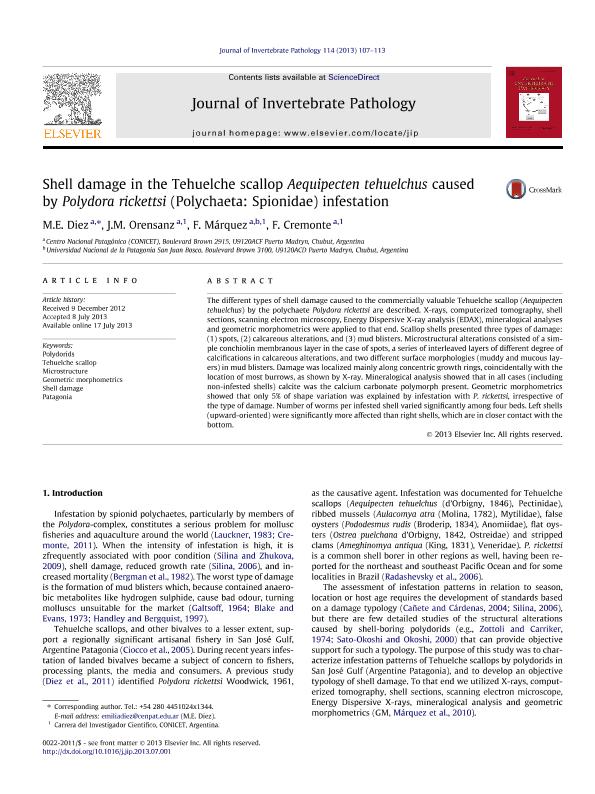Artículo
Shell damage in the Tehuelche scallop Aequipecten tehuelchus caused by Polydora rickettsi (Polychaeta: Spionidae) infestation
Fecha de publicación:
08/2013
Editorial:
Academic Press Inc Elsevier Science
Revista:
Journal of Invertebrate Pathology
ISSN:
0022-2011
Idioma:
Inglés
Tipo de recurso:
Artículo publicado
Clasificación temática:
Resumen
The different types of shell damage caused to the commercially valuable Tehuelche scallop (Aequipecten tehuelchus) by the polychaete Polydora rickettsi are described. X-rays, computerized tomography, shell sections, scanning electron microscopy, Energy Dispersive X-ray analysis (EDAX), mineralogical analyses and geometric morphometrics were applied to that end. Scallop shells presented three types of damage: (1) spots, (2) calcareous alterations, and (3) mud blisters. Microstructural alterations consisted of a simple conchiolin membranous layer in the case of spots, a series of interleaved layers of different degree of calcifications in calcareous alterations, and two different surface morphologies (muddy and mucous layers) in mud blisters. Damage was localized mainly along concentric growth rings, coincidentally with the location of most burrows, as shown by X-ray. Mineralogical analysis showed that in all cases (including non-infested shells) calcite was the calcium carbonate polymorph present. Geometric morphometrics showed that only 5% of shape variation was explained by infestation with P. rickettsi, irrespective of the type of damage. Number of worms per infested shell varied significantly among four beds. Left shells (upward-oriented) were significantly more affected than right shells, which are in closer contact with the bottom.
Archivos asociados
Licencia
Identificadores
Colecciones
Articulos(CCT-CENPAT)
Articulos de CTRO.CIENTIFICO TECNOL.CONICET - CENPAT
Articulos de CTRO.CIENTIFICO TECNOL.CONICET - CENPAT
Citación
Diez, María Emilia; Orensanz, Jose Maria; Marquez, Federico; Cremonte, Florencia; Shell damage in the Tehuelche scallop Aequipecten tehuelchus caused by Polydora rickettsi (Polychaeta: Spionidae) infestation; Academic Press Inc Elsevier Science; Journal of Invertebrate Pathology; 114; 2; 8-2013; 107-113
Compartir
Altmétricas




